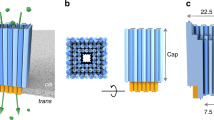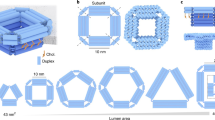Abstract
Protein nanopores such as α-haemolysin and Mycobacterium smegmatis porin A (MspA) can be used to sequence long strands of DNA at low cost. To provide high-speed sequencing, large arrays of nanopores are required, but current nanopore sequencing methods rely on ionic current measurements from individually addressed pores and such methods are likely to prove difficult to scale up. Here we show that, by optically encoding the ionic flux through protein nanopores, the discrimination of nucleic acid sequences and the detection of sequence-specific nucleic acid hybridization events can be parallelized. We make optical recordings at a density of ∼104 nanopores per mm2 in a single droplet interface bilayer. Nanopore blockades can discriminate between DNAs with sub-picoampere equivalent resolution, and specific miRNA sequences can be identified by differences in unzipping kinetics. By creating an array of 2,500 bilayers with a micropatterned hydrogel chip, we are also able to load different samples into specific bilayers suitable for high-throughput nanopore recording.
This is a preview of subscription content, access via your institution
Access options
Subscribe to this journal
Receive 12 print issues and online access
$259.00 per year
only $21.58 per issue
Buy this article
- Purchase on Springer Link
- Instant access to full article PDF
Prices may be subject to local taxes which are calculated during checkout





Similar content being viewed by others
References
Mardis, E. R. Anticipating the $1,000 genome. Genome Biol. 7, 112 (2006).
Bayley, H. Sequencing single molecules of DNA. Curr. Opin. Chem. Biol. 10, 628–637 (2006).
Xuan, J. K., Yu, Y., Qing, T., Guo, L. & Shi, L. M. Next-generation sequencing in the clinic: promises and challenges. Cancer Lett. 340, 284–295 (2013).
Branton, D. et al. The potential and challenges of nanopore sequencing. Nature Biotechnol. 26, 1146–1153 (2008).
Venkatesan, B. M. & Bashir, R. Nanopore sensors for nucleic acid analysis. Nature Nanotech. 6, 615–624 (2011).
Huang, S. Nanopore-based sensing devices and applications to genome sequencing: a brief history and the missing pieces. Chin. Sci. Bull. 59, 4918–4928 (2014).
Cockroft, S. L., Chu, J., Amorin, M. & Ghadiri, M. R. A single-molecule nanopore device detects DNA polymerase activity with single-nucleotide resolution. J. Am. Chem. Soc. 130, 818–820 (2008).
Chu, J., Gonzalez-Lopez, M., Cockroft, S. L., Amorin, M. & Ghadiri, M. R. Real-time monitoring of DNA polymerase function and stepwise single-nucleotide DNA strand translocation through a protein nanopore. Angew. Chem. Int. Ed. 49, 10106–10109 (2010).
Lieberman, K. R. et al. Processive replication of single DNA molecules in a nanopore catalyzed by phi29 DNA polymerase. J. Am. Chem. Soc. 132, 17961–17972 (2010).
Pennisi, E. DNA sequencers still waiting for the nanopore revolution. Science 343, 829–830 (2014).
Cherf, G. M. et al. Automated forward and reverse ratcheting of DNA in a nanopore at 5-angstrom precision. Nature Biotechnol. 30, 344–348 (2012).
Manrao, E. A. et al. Reading DNA at single-nucleotide resolution with a mutant MspA nanopore and phi29 DNA polymerase. Nature Biotechnol. 30, 349–353 (2012).
Laszlo, A. H. et al. Decoding long nanopore sequencing reads of natural DNA. Nature Biotechnol. 32, 829–833 (2014).
Bayley, H. Nanopore sequencing: from imagination to reality. Clin. Chem. 61, 25–31 (2015).
Heron, A. J., Thompson, J. R., Cronin, B., Bayley, H. & Wallace, M. I. Simultaneous measurement of ionic current and fluorescence from single protein pores. J. Am. Chem. Soc. 131, 1652–1653 (2009).
Bayley, H. et al. Droplet interface bilayers. Mol. Biosyst. 4, 1191–1208 (2008).
Ivankin, A. et al. Label-free optical detection of biomolecular translocation through nanopore arrays. ACS Nano 8, 10774–10781 (2014).
Anderson, B. N. et al. Probing solid-state nanopores with light for the detection of unlabeled analytes. ACS Nano 8, 11836–11845 (2014).
Demuro, A. et al. Calcium dysregulation and membrane disruption as a ubiquitous neurotoxic mechanism of soluble amyloid oligomers. J. Biol. Chem. 280, 17294–17300 (2005).
Zou, H., Lifshitz, L. M., Tuft, R. A., Fogarty, K. E. & Singer, J. J. Visualization of Ca2+ entry through single stretch-activated cation channels. Proc. Natl Acad. Sci. USA 99, 6404–6409 (2002).
Wang, S. Q., Song, L. S., Lakatta, E. G. & Cheng, H. P. Ca2+ signalling between single L-type Ca2+ channels and ryanodine receptors in heart cells. Nature 410, 592–596 (2001).
Stoddart, D., Heron, A. J., Mikhailova, E., Maglia, G. & Bayley, H. Single-nucleotide discrimination in immobilized DNA oligonucleotides with a biological nanopore. Proc. Natl Acad. Sci. USA 106, 7702–7707 (2009).
Wallace, E. V. B. et al. Identification of epigenetic DNA modifications with a protein nanopore. Chem. Commun. 46, 8195–8197 (2010).
Derrington, I. M. et al. Nanopore DNA sequencing with MspA. Proc. Natl Acad. Sci. USA 107, 16060–16065 (2010).
Manrao, E. A., Derrington, I. M., Pavlenok, M., Niederweis, M. & Gundlach, J. H. Nucleotide discrimination with DNA immobilized in the MspA nanopore. PLoS ONE 6, e25723 (2011).
Butler, T. Z., Pavlenok, M., Derrington, I. M., Niederweis, M. & Gundlach, J. H. Single-molecule DNA detection with an engineered MspA protein nanopore. Proc. Natl Acad. Sci. USA 105, 20647–20652 (2008).
Wang, Y., Zheng, D. L., Tan, Q. L., Wang, M. X. & Gu, L. Q. Nanopore-based detection of circulating microRNAs in lung cancer patients. Nature Nanotech. 6, 668–674 (2011).
Ambros, V. The functions of animal microRNAs. Nature 431, 350–355 (2004).
Bartel, D. P. MicroRNAs: genomics, biogenesis, mechanism, and function. Cell 116, 281–297 (2004).
Johnson, S. M. et al. RAS is regulated by the let-7 microRNA family. Cell 120, 635–647 (2005).
Gross, L. C. M., Castell, O. K. & Wallace, M. I. Dynamic and reversible control of 2D membrane protein concentration in a droplet interface bilayer. Nano Lett. 11, 3324–3328 (2011).
Coskun, A. F., Su, T. W. & Ozcan, A. Wide field-of-view lens-free fluorescent imaging on a chip. Lab on a Chip 10, 824–827 (2010).
Castell, O. K., Berridge, J. & Wallace, M. I. Quantification of membrane protein inhibition by optical ion flux in a droplet interface bilayer array. Angew. Chem. Int. Ed. 51, 3134–3138 (2012).
Acknowledgements
The authors thank D. Aarts for cleanroom access, T. Sapra for cleanroom training and E. Mikhailova for protein preparation. This work was supported by funding from the US National Human Genome Research Institute (NHGRI), ‘$1000 Genome’ research grant R01 HG003709, ERC StG 106913, and Oxford Nanopore Technologies Ltd.
Author information
Authors and Affiliations
Contributions
S.H., M.R.R., O.C., H.B. and M.I.W. designed the experiments. S.H., M.R.R. and O.C. performed the experiments. S.H. wrote the data analysis package program for the measurements with αHL, and performed the related data analysis. M.I.W. designed the data analysis methodology for the measurements with MspA. M.R.R. performed the MspA-related data analysis. S.H. designed and wrote the spotting robot program for the hydrogel array. S.H., M.R.R., O.C., H.B. and M.I.W. wrote the paper.
Corresponding author
Ethics declarations
Competing interests
H.B. is the founder, a director and a shareholder of Oxford Nanopore Technologies, a company engaged in the development of nanopore sensing and sequencing technologies. The work in this Article was supported in part by Oxford Nanopore Technologies. Methods developed by M.I.W. have been licensed by Oxford Nanopore Technologies.
Supplementary information
Supplementary information
Supplementary information (PDF 6080 kb)
Supplementary information
Supplementary Movie 1 (MOV 1977 kb)
Supplementary information
Supplementary Movie 2 (MOV 9693 kb)
Supplementary information
Supplementary Movie 3 (MP4 13996 kb)
Supplementary information
Supplementary Movie 4 (MOV 4801 kb)
Supplementary information
Supplementary Movie 5 (MOV 1804 kb)
Supplementary information
Supplementary Movie 6 (MOV 1089 kb)
Supplementary information
Supplementary Movie 7 (MOV 937 kb)
Rights and permissions
About this article
Cite this article
Huang, S., Romero-Ruiz, M., Castell, O. et al. High-throughput optical sensing of nucleic acids in a nanopore array. Nature Nanotech 10, 986–991 (2015). https://doi.org/10.1038/nnano.2015.189
Received:
Accepted:
Published:
Issue Date:
DOI: https://doi.org/10.1038/nnano.2015.189
This article is cited by
-
The ER calcium channel Csg2 integrates sphingolipid metabolism with autophagy
Nature Communications (2023)
-
High-resolution discrimination of homologous and isomeric proteinogenic amino acids in nanopore sensors with ultrashort single-walled carbon nanotubes
Nature Communications (2023)
-
Building programmable multicompartment artificial cells incorporating remotely activated protein channels using microfluidics and acoustic levitation
Nature Communications (2022)
-
Spatiotemporal stop-and-go dynamics of the mitochondrial TOM core complex correlates with channel activity
Communications Biology (2022)
-
Ionophore constructed from non-covalent assembly of a G-quadruplex and liponucleoside transports K+-ion across biological membranes
Nature Communications (2020)



